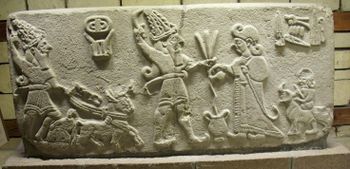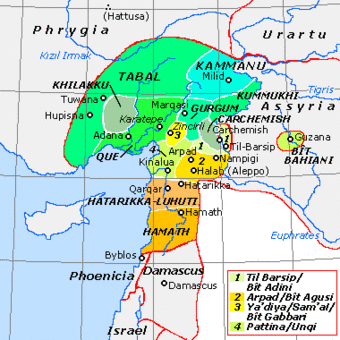الدول السورية-الحيثية
الدول المسماة الحيثية الجديدة Neo-Hittite، أو مؤخراً السورية-الحيثية Syro-Hittite كانت كيانات سياسية تتكلم اللغات اللوڤية والآرامية والفينيقية أثناء العصر الحديدي في شمال سوريا وجنوب الأناضول والتي نشأت إثر انهيار الامبراطورية الحيثية حوالي سنة 1180 ق.م. والتي استمرت حتى تقريباً سنة 700 ق.م. المصطلح "حيثية حديثة" أحياناً يُحجز خصيصاً للإمارات الناطقة باللوڤية مثل ميليد وكركميش، بالرغم من أنه بشكل أعم فإن المصطلح الأرحب ثقافياً، "السورية-الحيثية" يُستخدم حالياً لوصف كل الكيانات التي نشأت في جنوب-وسط الأناضول إثر الانهيار الحيثي — مثل تبل و قوى Quwê— وكذلك أولئك في شمال وساحل سوريا.[1]
الانتقال من العصر البرونزي المتأخر إلى العصر الحديدي المبكر

انهيار الامبراطورية الحيثية عادة ما يُقرن مع الانحدار التدريجي لشبكات التجارة في شرق المتوسط والانهيار الناتج للمدن الكبرى في أواخر العصر البرونزي في المشرق والأناضول وبحر إيجة.[2] ففي بداية القرن 12 ق.م.، دُمـِّرت ويلوسا (طروادة)[3] وعانت الامبراطورية الحيثية من هجوم مباغت ماحق من الكسكس، الذين احتلوا السواحل حول البحر الأسود، والذين ضموا قواتهم مع قوات Mysians. وقد تقدموا ليدمروا كل المواقع الحيثية إلا أنهم هـُزِموا على يد الآشوريين وراء الحدود الجنوبية بالقرب من نهر دجلة.[4] حاتي وأرزاوا (ليديا)، ألشية (قبرص)، اوغاريت وألالاخ دُمـِّروا.[5]

حاتوشا، العاصمة الحيثية، دُمـِّرت عن بكرة أبيها. وبعد ذلك الانهيار للمدن والدولة الحيثية، شهد العصر الحديدي المبكر في شمال بلاد الرافدين تبعثر المستوطنات وترييفاً للحضارة، مع ظهور عدد كبير من القرى والضياع والمزارع.[6] وبزغت الدول السورية-الحيثية في سياق هذا التحول الشاسع، على شكل دويلات إقليمية ذات بنى سياسية وانتماءات ثقافية جديدة. وقد تمكن ديڤد هوكن من تتبع تسلسل السلالات بين الأسرة الامبراطورية الحيثية و "الملوك العظام" و "سادة البلدان" بما يدل على اتصال غير منقطع بين أواخر العصر البرونزي ومطلع العصر الحديدي في تلك المواقع.[7]
Aside from literary evidence from inscriptions, the uninterrupted cultural continuity of الدول الحيثية الجديدة في المنطقة من آخر العصر البرونزي إلى مطلع العصر الحديدي is now further confirmed by recent archaeological work at the Temple of the Storm God on the citadel of Aleppo,[8] and Ain Dara temple,[9] where the Late Bronze Age temple buildings continue into the Iron Age without hiatus, with repeated periods of construction في أوائل العصر الحديدي.
قائمة الدول السورية-الحيثية
يمكن تقسيم الدول السورية-الحيثية إلى مجموعتين: مجموعة شمالية حيث ظل الحكام الحيثيون في السلطة، ومجموعة جنوبية حيث حكم الأراميون منذ نحو عام 1000 ق.م. These states were highly decentralised structures; some appear to have been only loose confederations of sub-kingdoms.[10][11]
المجموعة الشمالية تضم:
- تبل. وقد تكون قد ضمت مجموعة من المدن-الدول المسماة Tyanitis (Tuwana, Tunna, Hupisna, Shinukhtu, Ishtunda)
- Kammanu (مع مليد)
- Hilakku
- قوى Quwê (مع معقل في قرة تپه الحالية)
- Gurgum
- Kummuh
- كركميش
المجموعة الجنوبية، الأرامية، تضم:
- پـَلـِستين Palistin (وعاصمتها المحتملة تل طيـِّنات)[12][13]
- بيت گبـّاري (مع سمأل)
- Bit-Adini (مع مدينة Til Barsip)
- بيت باهياني (مع Guzana)
- Pattin (أيضاً پاتـِّينا أو عـُنقي) (ومدينة Kinalua، التي ربما هي Tell Tayinat الحالية [14])
- Ain Dara، المركز الديني
- بيت أگوسي (مع مدن Arpad, Nampigi, و(لاحقاً على) حلب)
- Hatarikka-Luhuti (وعاصمتها كانت Hatarikka)
- حمات
النقوش
نقوش الصروح اللوڤية في الهيروغليفية الأناضولية تتواصل دون انقطاع من الصروح الامبراطورية الحيثية في القرن 13 ق.م. إلى النقوش السورية-الحيثية في مطلع العصر الحديدي في كركميش، مليد، حلب وغيرهم.[15] Luwian hieroglyphs were chosen by many of the Syro-Hittite regional kingdoms for their monumental inscriptions, which often appear in bi or tri-lingual inscriptions with Aramaic, Phoenician or Akkadian versions. The Early Iron Age in Northern Mesopotamia also saw a gradual spread of alphabetic writing in Aramaic and Phoenician. During the cultural interactions on the Levantine coast of Syro-Palestine and North Syria in the tenth through 8th centuries BCE, Greeks and Phrygians adopted the alphabetic writing from the Phoenicians.[16]
انظر أيضاً
| الآراميون |
|---|
| الدول السورية-الحيثية |
| الملوك الآراميون |
| المدن الآرامية |
الهامش
- ^ Hawkins, John David; 1982a. “Neo-Hittite States in Syria and Anatolia” in Cambridge Ancient History (2nd ed.) 3.1: 372-441. Also: Hawkins, John David; 1995. "The Political Geography of North Syria and South-East Anatolia in the Neo-Assyrian Period" in Neo-Assyrian Geography, Mario Liverani (ed.), Università di Roma “La Sapienza,” Dipartimento di Scienze storiche, archeologiche e anthropologiche dell’Antichità, Quaderni di Geografia Storica 5: Roma: Sargon srl, 87-101.
- ^ See Hawkins, John David; 1994. “The end of the Bronze age in Anatolia: new light from recent discoveries,” in Anatolian Iron Ages 3: Proceedings of the Third Anatolian Iron Ages Colloquium, Altan Çilingiroğlu and David H. French (eds.); The British Institute of Archaeology at Ankara Monograph 16: London, 91-94.
- ^ C.Mossé (1984).La Gréce archaicque d'Homére á Eschýle.Editions du Seuil.Paris p.35
- ^ O.R.Gurney (1978).The Hittites.Oxford University Press .London pp.49-50
- ^ O.R.Gurney (1978).The Hittites.Oxford University Press.London. pp.49-50
- ^ See Wilkinson, Tony J.; 2003. Archaeological landscapes of the Near East. Tucson: The University of Arizona Press.
- ^ See "Karkamish" and "Melid" in Hawkins, John David; 2000. Corpus of Hieroglyphic Luwian Inscriptions. (3 vols) De Gruyter: Berlin. Also: Hawkins, John David; 1995b. “Great Kings and Country Lords at Malatya and Karkamis” in Studio Historiae Ardens: Ancient Near Eastern Studies Presented to Philo H.J. Houwink ten Cate, Theo P.J. van den Hout and Johan de Roos (eds.), Istanbul: 75-86.
- ^ Kohlmeyer, Kay; 2000a. Der Tempel des Wettergottes von Aleppo. Münster: Rhema.
- ^ Abū Assaf, Alī; 1990. Der Tempel von ءAin Dārā. Mainz am Rhein: Verlag Philipp von Zabern.
- ^ Tübinger Bibelatlas / Tübingen Bible Atlas. Siegfried Mittmann, Götz Schmitt (eds.), Stuttgart: Deutsche Bibelgesellschaft, 2001, Map B IV 13-14
- ^ O.R. Gurney, The Hittites. Harmondsworth: Pelican, 2nd ed., 1976 = 1954. p. 39-46.
- ^ Trevor Bryce. The World of The Neo-Hittite Kingdoms: A Political and Military History. p. 129.
- ^ D. T. Potts. A Companion to the Archaeology of the Ancient Near East. p. 802.
- ^ See the Tayinat Website by the Department of Near & Middle Eastern Civilizations at the University of Toronto
- ^ Hawkins, John David; 1986b. “Writing in Anatolia: imported and indigenous systems,” WA 17: 363-376; Hawkins; 2000. Corpus of Hieroglyphic Luwian Inscriptions. Volume I, Inscriptions of the Iron Age, De Gruyter, pp. 17-23; Giusfredi; Federico; 2010. Sources for a Socio-Economic History of the Neo-Hittie States, Winter Verlag, pp. 37-44; Simon, Zsolt; 2011. Hethitische Topoi in der hieroglyphen-luwischen Historiographie: Bemerkungen zur Frage der Kontinuität, in M. Hutter and S. Hutter-Braunsar, Hethitische Literatur Überlieferungsprozess,Textstrukturen, Ausdrucksformen Und Nachwirken, Ugarit Verlag, pp. 227-244.
- ^ Brixhe, C. and M. Lejeune (1984). Corpus des inscriptions paléo-phrygiennes. Paris.


